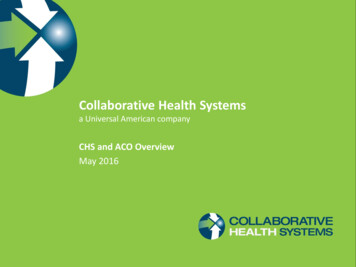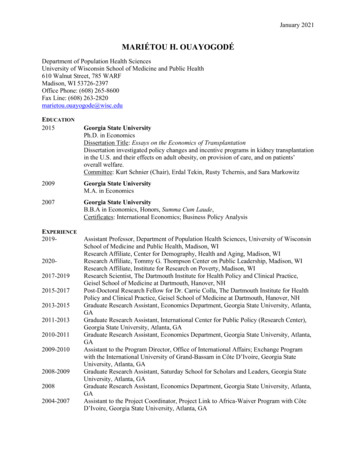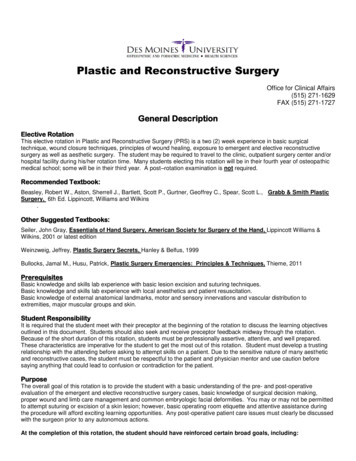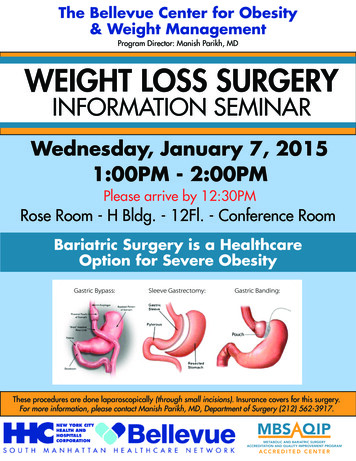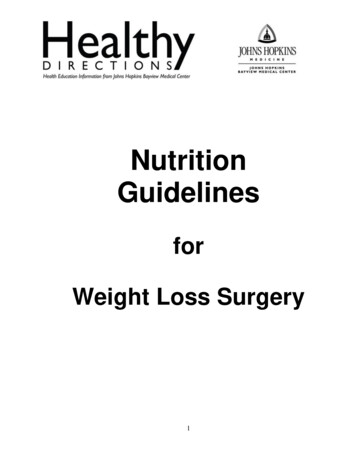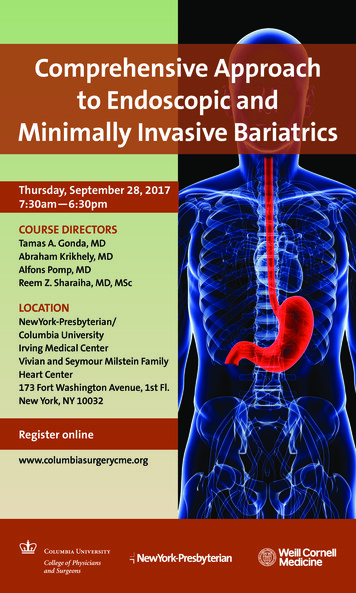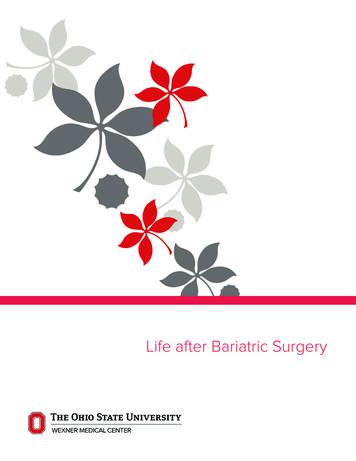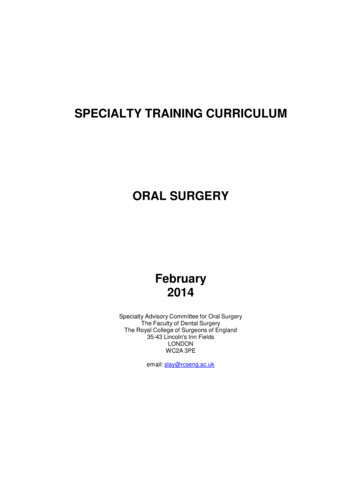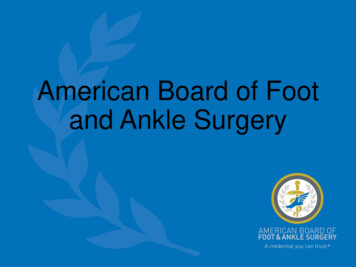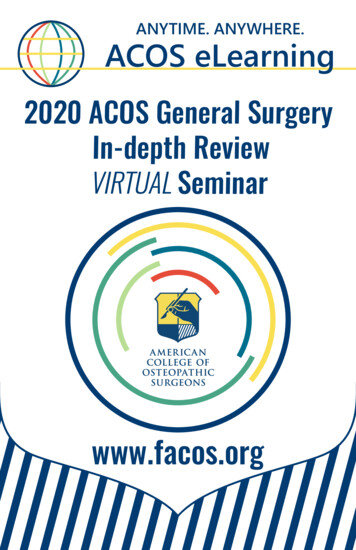
Transcription
ANYTIME. ANYWHERE.ACOS eLearning2020 ACOS General SurgeryIn-depth ReviewSeminarwww.facos.org
RID2020In-depth ReviewTABLE OF CONTENTSPROGRAM OVERVIEW. 3STATEMENT OF NEED. 3LEARNING OBJECTIVES. 3PROGRAM CHAIRS. 4COMMITTEE MEMBERS. 4AOA CME REQUIREMENTS. 5QUESTIONS AND CONCERNS REGARDING CME. 5PLANNERS AND MANAGERS. 5SPEAKER DISCLOSURE STATEMENT. 6DISCLOSURE OF UNLABELED USE. 6DISCLAIMER. 6PROGRAM PRESENTATIONS.7REFERENCES.10SPEAKERS AND COMMITTEE MEMBERS WITH DISCLOSURES.24SPEAKERS AND COMMITTEE MEMBERS WITH NOTHING TO DISCLOSE.242
RID2020In-depth ReviewPROGRAM OVERVIEWThe Program Chairs for the American College of Osteopathic Surgeons’ (ACOS)2020 General Surgery In-depth Review VIRTUAL Seminar (IDR) – Jessica L. Bartock,DO and Annika C. Storey, DO, FACOS along with the full support of the ACOS Indepth Review Committee developed a first-rate board exam review course. TheIDR is designed to provide surgeons with a comprehensive educational review onthe presented topics. Participants in this course will find it a helpful experience inpreparing for certification or recertification examinations.*IDR sessions provide a deep dive into the topics covered in the AmericanOsteopathic Board of Surgery (AOBS) General Surgery certification examinations.Our panel of presenters will discuss the purpose and focus of the exam as wellas what examiners are looking for. The intent is to be a thorough review of theexamination topics as well as an update for the general surgeon in practice.Due to the outbreak of COVID-19 (Novel Coronavirus), the 2020 Seminar is beingheld virtually. Our General Surgery VIRTUAL In-depth Review Seminar is launchingin the ACOS eLearning Portal on April 22, 2020. Registrants of the program willhave access to sessions through their ACOS eLearning account. This means thatattendees have the benefit of earning quality continuing medical education (CME)credits and/or preparing for the certification or recertification exams at theirconvenience – Anytime, Anywhere, ACOS eLearning!STATEMENT OF NEEDGeneral Surgeons need thorough knowledge of the most recent developmentsand techniques as well as established guidelines in surgery to ensure the higheststandards of patient care and safety.LEARNING OBJECTIVESAt the conclusion of this activity, learners will be better able to: apply knowledge gained in preparing for board certification or recertificationexaminations. comprehend the indications, techniques, complications, and outcomespresented of various surgical procedures. employ techniques described into their surgical practice to improve patientcare.* ACOS does not guarantee results on any certification or recertification exams.3
RID2020In-depth ReviewPROGRAM CHAIRSJessica L. Bartock, DOCOMMITTEE MEMBERS4Annika C. Storey, DO, FACOS Nelayda Fonte, DO, FACOS Chairman & Board Liaison Jessica L. Bartock, DO Hania B. Bednarski, DO, FACOS Marc A. Campbell, DO, FACOS David Lee Coffman, DO Christopher L. Finley, DO Jesse J. Lopez, Jr., DO, FACOS Marylou Rainone, DO, FACOS Benjamin A. Raymond, DO Victoria L. Schlanser, DO Annika C. Storey, DO, FACOS Jennifer E. Susoreny-Velgos, DO Richard J. Unger, DO
RID2020Attendee InformationAOA CME REQUIREMENTSThe American College of Osteopathic Surgeons (ACOS) is accredited by theAmerican Osteopathic Association (AOA) to provide osteopathic continuingmedical education for physicians. Eligible attending physicians can earn AmericanOsteopathic Association continuing medical education (CME) credit by participatingin the educational programs and activities at the 2020 In-depth Review Seminar.ACOS estimates that the AOA Council on Continuing Medical Education will approvethis program for a maximum of 29 AOA Category 1-A CME credit hours.In accordance with the AOA CME accreditation requirements, the attendee mustcomplete an evaluation of each session attended as well as an overall eventevaluation in order to receive AOA CME credit. Physicians should only claim creditcommensurate with the extent of their participation in the educational activity.Information on how participants can claim their CME hours will be provided toeligible attendees. After the program evaluation has been completed, a CMEcertificate can be printed by the registrant. ACOS will report CME credits equal tothe extent of the physician’s participation in this activity.QUESTIONS AND CONCERNS REGARDING CMEAny questions or concerns regarding the CME requirements, credits earned for thismeeting, or problems such as facilities, handouts, and program content may bedirected to the ACOS staff by calling (800) 888-1312. Unresolved issues regardingthe compliance of this meeting with the AOA accreditation requirements may bebrought to the attention of the AOA Division of CME by calling (888) 626-9262.Any formal action by the AOA will require a written communication from you.PLANNERS AND MANAGERSACOS planners and managers, Stephanie Santini, CMP, and Natasha Moussavi havenothing to disclose.5
RID2020Attendee InformationSPEAKER DISCLOSURE STATEMENTThe American College of Osteopathic Surgeons (ACOS) is accredited by the Inaccordance with the AOA Standards of Accreditation; and ACCME Essential Criteriaand Policies and Standards for Commercial Support; and AMA PRA Category 1Guidelines, speakers with an asterisk (*) following their name have indicatedthat they have a relationship which in the context of their presentation, could beperceived by some as real or apparent conflict of interest (e.g., ownership of stock,speaker honoraria, consulting fees, etc.) but do not consider it will influence theirpresentation.DISCLOSURE OF UNLABELED USEThis educational activity may contain discussion of published and/or investigationaluses of agents that are not indicated by the FDA. The planners of this activitydo not recommend the use of any agent outside of the labeled indications. Theopinions expressed in the educational activity are those of the faculty and donot necessarily represent the views of the planners. Please refer to the officialprescribing information for each product for discussion of approved indications,contraindications, and warnings.DISCLAIMERParticipants have an implied responsibility to use the newly acquired informationto enhance patient outcomes and their own professional development. Theinformation presented in this activity is not meant to serve as a guideline forpatient management. Any procedures, medications, or other courses of diagnosisor treatment discussed or suggested in this activity should not be used by clinicianswithout evaluation of their patient’s conditions and possible contraindications and/or dangers in use, review of any applicable manufacturer’s product information,and comparison with recommendations of other authorities.6
RID2020In-depth ReviewPROGRAM PRESENTATIONSCME Credits Presentation0.00Welcome and Introductions Annika Storey, DO, FACOS; Jessica Bartock, DO0.25Tips and Tricks for Passing the Oral Boards Benjamin Raymond, DO, FACOS1.00Newborn/Infant Surgical Emergencies Stephanie Jones, DO1.00Toddler/Child Surgical Emergencies Stephanie Jones, DO0.75OB/GYN Considerations for the General Surgeon Lindsay Wardle, DO0.75Bariatric Surgical Emergencies Jesse Lopez Jr., DO, FACOS0.50Evaluation & Management of Adrenal Masses T.K. Pandian, MD, MPH0.50Evaluation & Management of MEN Syndromes T.K. Pandian, MD, MPH0.75Anesthesia & Pain Management for the Surgeon Coleen Vernick, DO1.00Ventilator Management & ARDS Annika Storey, DO, FACOS0.75Shock Resuscitation and It’s Endpoints Nelayda Fonte, DO, FACOS, FICS0.75Sepsis and Antibiotic Management David Lee Coffman, DO0.50Fluids, Electrolytes, and Nutrition Sara Buckman, MD, PharmD, FACS0.75Trauma Review I Matthew LaPorta, DO0.75Malignant Melanoma Hillary Johnson, MD, PhD, MHCDS0.50Breast 101, Benign Breast Disease Roxane Weighall, DO**Indicates a financial disclosure. See page 24 for more information.7
RID2020In-depth ReviewPROGRAM PRESENTATIONSCME Credits Presentation80.50Breast Imaging Roxane Weighall, DO*0.75Breast Cancer Work Up Hania Bednarski, DO, FACOS*0.75Breast Cancer Treatment & Reconstruction Hania Bednarski, DO, FACOS*0.50Burn Injury Laura Johnson, MD0.50Trauma Review II Laura Johnson, MD0.75Thyroid Malignancy Geeta Lal, MD, MSc, FACS0.75Operative Indications & Challenges in Parathyroid Surgery Geeta Lal, MD,MSc, FACS0.75Workup & Surgery in Benign Esophageal Disease Omar Awais, DO0.50Esophageal Cancer Omar Awais, DO0.50Neuroendocrine Tumors and Neuroendocrine Carcinomas of the GI Track David Kermode, DO, FACOS0.50Gastric Cancer Jeremiah Deneve, DO, FACS0.50GIST Jeremiah Deneve, DO, FACS0.50Benign and Malignant Hepatic Tumors Nikolaos Dallas, MD, FACS0.50Screening & Treatment of Portal Hypertension Nikolaos Dallas, MD, FACS0.75Inflammatory Bowel Disease for Surgeons James McCormick, DO, FACS,FASCRS**Indicates a financial disclosure. See page 24 for more information.
RID2020In-depth ReviewPROGRAM PRESENTATIONSCME Credits Presentation0.50Mesenteric Ischemia Christopher Esper, DO, FACOS0.75Appendiceal Disease David Kermode, DO, FACOS0.75Benign & Malignant Colon Disease and Polyposis Syndromes Scott Nelson,DO0.50Diagnosis and Treatment of Rectal Cancer and Disease Scott Nelson, DO0.50Benign and Malignant Anal Disease Scott Nelson, DO0.75Benign Biliary Tree Conditions Pablo Giuseppucci, MD, FACS0.75Malignant Biliary Tree Conditions Jeremiah Deneve, DO, FACS0.50Sarcoma Douglas Iddings, DO, FACOS0.50Benign Lesions of the Pancreas Nikolaos Dallas, MD, FACS0.50Malignant Pancreatic Disease Pablo Giuseppucci, MD, FACS0.75Abdominal Aortic Aneurysm Christopher Esper, DO, FACOS0.75Carotid Artery Disease & Treatment Christopher Esper, DO, FACOS1.00Peripheral Vascular Occlusive Disease Jon Henwood, DO, FACOS1.00Diagnosis & Treatment of Venous Disease Jon Henwood, DO, FACOS9
RID2020In-depth ReviewREFERENCESTips and Tricks for Passing the Oral Boards Benjamin Raymond, DO, FACOS American Osteopathic Board of Surgery (AOBS) Website - https://certification.osteopathic.org/surgery/ General Surgery Review: Certifying Edition, The Pass Machine Review CourseNewborn/Infant Surgical Emergencies Stephanie Jones, DO Pediatric Surgery NaT. American Pediatric Surgical Association 2017. Juang D, Snyder CL: Neonatal Bowel obstruction. Surg Clin North Am. 92:685,2012 Lilien LD, Srinivasan G, et al. Green vomiting in the first 72 hours in normal infants. Am J Dis Child1986 Jul 140(7)p 662-4.Toddler/Child Surgical Emergencies Stephanie Jones, DO Holcomb GW III, Murphy JP. Ashcraft’s Pediatric Surgery. 5th ed. Philadelphia, PA: Saunders AnImprint of Elsevier, 2010. Tataria M, Nance ML, Holmes JH 4th, Miller CC 3rd, Mattix KD, Brown RL, Mooney DP, Scherer LR 3rd,Grooner JI, Scaife ER, Spain DA, Brundage SI. Pediatric blunt abdominal injury: age is irrelevant anddelayed operation is not detrimental. J Trauma 2007 Sep;63(3):608-14. Gates et al. Non-operative management of solid organ injuries in children: An American PediatricSurgical Association Outcomes and Evidence Based Practice Committee systematic review. J PediatrSurg. 2019 Jan 31. epub.10
RID2020In-depth ReviewREFERENCESOB/GYN Considerations for the General Surgeon Lindsay Wardle, DO American College of Obstetricians and Gynecologists. (2018). ACOG Practice Bulletin no. 193: TubalEctopic Pregnancy. Obstet Gynecol. 131 (3): e91-e103. Encyclopedia Britannica Website. fallopian-tube.Accessed March 20, 2020. Perinatology.com Website. http://perinatology.com/images/betaHCG.jpg. Accessed March 20.2020. Mayo Clinic Website. rine-fibroids/symptomscauses/syc-20354288. Accessed March 31, 2020. Center for Disease Control Website. https://www.cdc.gov/std/tg2015/pid.htm. Accessed March 20,2020. Ross, Jonathan and Mariam Chacko. Uptodate. Pelvic inflammatory disease: Clinical manifestationsand diagnosis. Updated 2/2/2020. American College of Obstetricians and Gynecologists. (2017). ACOG Practice Bulletin no. 182 :Hereditary Breast and Ovarian Cancer Syndrome. Available hereditary-breast-and-ovariancancer-syndrome.pdf. Accessed April 1, 2020. Perinatology.com Website. Normal Reference Ranges and Laboratory Values In Pregnancy. es/Reference%20for%20Serum.htm. AccessedMarch 31, 2020. SAGES Website. py-for-surgical-problems-during-pregnancy/. Accessed March 31. 2020. Pregnancy-Associated Breast Cancer. Rev Obstet Gynecol. 2012; 5(2): 94–99. 08/. Accessed March 31, 2020. Pregnancy Week by Week Calendar Website. ncy.html. Accessed March 31, 2020. Vasileiou G.,Eid A., Qian S., et al. Appendicitis in Pregnancy: A Post-Hoc Analysis of an EASTMulticenter Study. Surgical Infections. 2020; (3). Advanced online publication. DOI: 10.1089/sur.2019.102 American College of Obstetricians and Gynecologists. (2018). ACOG Committee Opinion no. 723:Diagnostic Imaging During Pregnancy and Lactation. Obstet Gynecol. 130 (4): e210-e216. American College of Obstetricians and Gynecologists. (2019). ACOG Committee Opinion no. 775:Nonobstetric Surgery During Pregnancy. Obstet Gynecol. 133 (4): e285-e286.11
RID2020In-depth ReviewREFERENCESBariatric Surgical Emergencies Jesse Lopez Jr., DO, FACOS World J Emerg Surg. 2013; 8: 58. Abdulzahra Hussain and Shamsi EL-Hasani Andrey Vizhul, et al; Journal of Medical Cases, Vol 2, Number5, Oct. 2011, pages 194-196 Development of ulcer disease after Roux-en-Y gastric bypass, incidence, risk factors, and patientpresentation: a systematic review. Obes Surg luation & Management of Adrenal Masses T.K. Pandian, MD, MPH Zeiger MA et al. American Association of Clinical Endocrinologists and American Association ofEndocrine Surgeons Medical Guidelines for the Management of Adrenal Incidentalomas. EndocrinePractice. 2009;15:Suppl 1 Young WF. The Incidentally Discovered Adrenal Mass. NEJM. 2007:356(6):601-610 Gruber LM et al. Pheochromocytoma Characteristics and Behavior Differ Depending on Method ofDiscovery. J Clin Endocrinol Metab. 2019;104(5):1386 Vaidya A et al. The Expanding Spectrum of Primary Aldosteronism: Implications for Diagnosis,Pathogenesis, and Treatment. Endocrine Reviews. 2018;39:1057-1088 Kayser SC et al. Study Heterogeneity and Estimation of Prevalence of Primary Aldosteronism: ASystematic Review and Meta-Regression Analysis. J Clin Endocrinol Metab. 2016;101(7):2826 Rossi GP et al. An expert consensus statement on use of adrenal vein sampling for the subtyping ofprimary aldosteronism. Hypertension. 2014;63(1):151-160 Lim V et al. Accuracy of adrenal imaging and adrenal venous sampling in predicting surgical cure ofprimary aldosteronism. JCEM. 2014;99(8):2712-2719 Kempers MJ et al. Systematic review: diagnostic procedures to differentiate unilateral from bilateraladrenal abnormality in primary aldosteronism. Ann Intern Med. 2009;151(5):329. Ishidoya S et al. Laparoscopic partial versus total adrenalectomy for aldosterone producing adenoma.J Urol. 2005;174(1):4012
RID2020In-depth ReviewREFERENCESEvaluation & Management of MEN Syndromes T.K. Pandian, MD, MPH Kiernan CM et al. Surgical Management of Multiple Endocrine Neoplasia 1 and Multiple EndocrineNeoplasia 2. Surg Clin N Am. 2019;99:693-706 Brandi ML et al. Guidelines for Diagnosis and Therapy of MEN Type 1 and Type 2. J Clin EndocrinolMetab. 2001;86:5658-5671. Thakker RV et al. Clinical Practice Guidelines for Multiple Endocrine Neoplasia Type 1 (MEN1). J ClinEndocrinol Metab. 2012;97:2990-3011. Norton JA et al. Prospective study of surgery for primary hyperparathyroidism (HPT) in multipleendocrine neoplasia-type 1 and Zollinger-Ellison syndrome: long-term outcome of a more virulent formof HPT. Ann Surg. 2008;247(3):501-510. Wilhelm SM et al. The American Association of Endocrine Surgeons Guidelines for DefinitiveManagement of Primary Hyperparathyroidism. JAMA Surg. 2016;151(10):959-968. Wells SA et al. Revised American Thyroid Association Guidelines for the Management of MedullaryThyroid Carcinoma. Thyroid. 2015;6:567-610. Neumann HP et al. Comparison of Pheochromocytoma-Specific Morbidity and Mortality Among AdultsWith Bilateral Pheochromocytomas. JAMA Network Open. 2019;2(8). Undergoing Total Adrenalectomy vs Cortical-Sparing Adrenalectomy Baghai M et al. Pheochromocytomas and paragangliomas in von Hippel-Lindau disease: a role forlaparoscopic and cortical-sparing surgery. Arch Surg. 2002;137(6):682-688. Hammel PR et al. Pancreatic involvement in von Hippel-Lindau disease. The Groupe Francophoned’Etude de la Maladie de von Hippel-Lindau. Gastroenterology. 2000;119(4):1087. Walther MM et al. von Recklinghausen’s disease and pheochromocytomas. J Urol. 1999;162(5):15821586. Gruber LM et al. Pheochromocytoma and paraganglioma in patients with neurofibromatosis type 1.Clin Endocrinol. 2017;86(1):141-149. Welander J et al. Genetics and clinical characteristics of hereditary pheochromocytomas andparagangliomas. Endocr Relat Cancer. 2011 Dec;18(6):R253-76 Mountjoy L et al. Glucagonoma-associated rash. N Engl J Med. 2017;376:10 Smith SL et al. Vasoactive intestinal polypeptide secreting islet cell tumors: a 15-year experience andreview of the literature. Surgery. 1998;124(6):1050-1055. Teh BT et al. Clinicopathologic studies of thymic carcinoids in multiple endocrine neoplasia type 1.Medicine (Baltimore). 1997 Jan;76(1):21-29.13
RID2020In-depth ReviewREFERENCESAnesthesia & Pain Management for the Surgeon Coleen Vernick, DO 2013 ACC/AHA Guideline on the Assessment of Cardiovascular Risk. Journal of the American Collegeof Cardiology Vol. 63, No. 25, 2014 Practice Guidelines for Acute Pain Management in the Perioperative Setting, An Updated Report bythe American Society of Anesthesiologists Task Force on Acute Pain Management, Anesthesiology.2012;1(16)248-273. Pardo, Manuel Pardo and Ronald Miller, Basics of Anesthesia 7th Edition. 2018Ventilator Management & ARDS Annika Storey, DO, FACOS Brower RG, Matthay MA, Morris A, Schoenfeld D, Thompson BT, Wheeler A. Acute RespiratoryDistress Syndrome Network. N Engl J Med. 2000 May 4;342(18):1301-8 Papazian L, Aubron C, Brochard L, Chiche JD, Combes A, Dreyfuss D, et al. Formal Guidelines:management of acute respiratory distress syndrome. Ann; Intensive Care. 2019 9:69. Bellani G, Laffey JG, Pham T, Fan E, BorchardL, Esteban A, et al. Epidemiology, patterns of care, andmortality for patients with acute respiratory distress syndrome in intensive care units in 50 countries.JAMA. 2016;315(8):788-800. Guerin C, Reignier J, Richard JC, Beuret P, Gacouin A, Boulain T, et al. Prone positioning in severeacute respiratory distress syndrome. N Engl J Med. 2013;368(23):2159-68. Combes A, Hajage D, Capellier G, Demoule A, Lavoue S, Guervilly C, et al. Extracorporeal membraneoxygenation for severe acute respiratory destress syndrome. N Engl J Med. 2018;378(21):1965-75. Papazian L, Forel JM, Gacouin A, Penot-Ragon C, Perrin G, Loundou A, et al. Neuromuscular blockers inearly acute respiratory distress syndrome. N Engl J Med. 2010;363(12):1107-16. Yang KL, Tobin MJ. A prospective study of indexes predicting the outcome of trials of weaning frommechanical ventilation. N Engl J Med. 1991;324:1445–50.14
RID2020In-depth ReviewREFERENCESShock Resuscitation and It’s Endpoints Nelayda Fonte, DO, FACOS, FICS Advanced Trauma Life Support For Doctors 10th Edition Trauma Mattox, Moore, Feliciano 7th edition Textbook of Critical Care 6th edition Vincent, Abraham, Moore, Kochanek, FinkSepsis and Antibiotic Management David Lee Coffman, DO Ferrer et al. Empiric antibiotic treatment reduces mortality in severe sepsis and septic shock fromthe first hour: results from a guideline-based performance improvement program. Crit Care Med2014. Gotts, J, and Matthay, M. Sepsis: Pathophysiology and clinical management. BMJ (Clinical Researched) 2016; 353: i1585 illu, K., Sarani B., Fundamental Critical Care Support. Life-threatening Infections: Diagnosis andAntimicrobial Therapy Selection. Mount Prospect, IL: Society of Critical Care Medicine; 2016.Fluids, Electrolytes, and Nutrition Sara Buckman, MD, PharmD, FACS Guidelines for the Provision and Assessment of Nutrition Support Therapy in the Adult Critically IllPatient: Society of Critical Care Medicine (SCCM) and American Society for Parenteral and EnteralNutrition (A.S.P.E.N.). Taylor BE, McClave SA, Martindale RG, Warren MM, Johnson DR, BraunschweigC, McCarthy MS, Davanos E, Rice TW, Cresci GA, Gervasio JM, Sacks GS, Roberts PR, Compher C;Society of Critical Care Medicine; American Society of Parenteral and Enteral Nutrition. Crit CareMed. 2016 Feb;44(2):390-438 Fluid management in perioperative and critically ill patients. Kang D, Yoo KY. Acute Crit Care. 2019Nov;34(4):235-245. doi: 10.4266/acc.2019.00717Trauma Review I Matthew LaPorta, DO www.aast.org www.east.org https://www.surgicalcore.org/Malignant Melanoma Hillary Johnson, MD, PhD, MHCDS 2019 NCCN Cutaneous Melanoma Guidelines; https://www.nccn.org/professionals/physician gls/ 2019 AAD Guidelines of care for the management of primary cutaneous melanoma; JAAD Volume 80,Issue 1, Pages 208–250; DOI: https://doi.org/10.1016/j.jaad.2018.08.055 Completion Dissection or Observation for Sentinel-Node Metastasis in Melanoma; N Engl J Med 2017;376:2211-2222; DOI: 10.1056/NEJMoa161321015
RID2020In-depth ReviewREFERENCESBreast 101, Benign Breast Disease Roxane Weighall, DO NCCN guidelines American Society of Breast Surgeons Consensus GuidelinesBreast Imaging Roxane Weighall, DO NCCN Guidelines American Society of Breast Surgeons Consensus GuidelinesBreast Cancer Work Up Hania Bednarski, DO, FACOS Breast Cancer Risk Calculator Updated for Asian-Americans; NIH; May 2011 Facts and Figures 2019; ACS; jan 2019Breast Cancer Treatment & Reconstruction Hania Bednarski, DO, FACOS The Feasibility of Breast conserving surgery for multiple ipsilateral breast cancer: An initial reportfrom ACOSOG (Alliance) Z11102 trial; KAri Rosenkrantz, MD et al; ASBrS; May 2018 Axillary Surgery; Judy Boughey, MD; ASBrS; May 2018 New Techniques for Sentinel Node Biopsy in Breast Cancer; Massimo Ferrucci, MD et al. TranslCancer Res 2018; 7 (Suppl 3): S405-S417Burn Injury Laura Johnson, MD SCORE Lectures - Burns & Inhalation Injury Advanced Burn Life Support (American Burn Association) Heimbach DM, Afromowitz MA, Engrav LH, Marvin JA, Perry B. Burn depth estimation—man ormachine. J Trauma 1984;24:373–8.Trauma Review II Laura Johnson, MD ATLS 10th Edition Frontera, J.A., Lewin III, J.J., Rabinstein, A.A., Aisiku, I.P., Alexandrov, A.W., Cook, A.M., del Zoppo, G.J.,Kumar, M.A., Peerschke, E.I.B., Stiefel, M.F., Teitelbaum, J.S., Wartenberg, K.E., & Zerfoss, C.L. (2015,December 29). Guideline for Reversal of Antithrombotics in Intracranial Hemorrhage: A Statement forHealthcare Professionals from the Neurocritical Care Society and Society of Critical Care Medicine.Neurocritical care., 24(1), 6-46. doi:10.1007/s12028-015-0222-x 1. Johansen K, Lynch K, Paun M, et al. Non-invasive vascular tests reliably exclude occult arterialtrauma in injured extremities. J Trauma 1991;31:515-522.16
RID2020In-depth ReviewREFERENCESThyroid Malignancy Geeta Lal, MD, MSc, FACS Haugen BR et al. Thyroid, 2016 ATA guidelines, Patel KN et al. Ann Surg, 2020 Cibas and Ali. Thryoid 2017 Ferris et al. Thyroid 2015, Haugen B et al. Thyroid 2016, Patel KN et al. Ann Surg 2020 Schwartz’s Textbook of Surgery, 11th edition Wells SA Jr et al. ATA guidelines MTC,2015 Smallridge KC et al. Thyroid 2012; Subbiah V et al. JCO 2018Operative Indications & Challenges in Parathyroid Surgery Geeta Lal, MD, MSc, FACS Schwartz’s Textbook of Surgery, 11th Edition Eastell R et al. JCEM 2014 Bilezikian J et al JCEM 2014 Rodgers S et al. Surgery 2006, Eichhorn-Wharry et al. Am J Surg 2011, Starker L et al. Ann SurgOncol 2011Workup & Surgery in Benign Esophageal Disease Omar Awais, DO Evidence-based clinical practice guidelines for gastroesophageal reflux disease 2015 KatsuhikoIwakiri, 2016 Esophageal Function Testing Beyond Manometry and Impedance Ravinder K. Mittal, 2014 Management of the Difficult Hiatal Hernia Matthew Rochefort, 2018Esophageal Cancer Omar Awais, DO Surgical Treatment for Esophageal Cancer Hiroyuki Kato, 2007 Current management of oesophageal cancer Naufal Rashid, 2015Neuroendocrine Tumors and Neuroendocrine Carcinomas of the GI Track David Kermode,DO, FACOS Surveillance, Epidemiology and End Results (SEER), US population 1974-2005Gastric Cancer Jeremiah Deneve, DO, FACS /Users/jigdeneve/Desktop/NCCN-Gastric 2020.pdf /Users/jigdeneve/Documents/Articles/Gastric Cancer/Perioperative chemtherapy versus surgeryalone for gastric cancer MAGIC trial-NEJM 2006.pdf /Users/jigdeneve/Documents/Articles/Gastric Cancer/FLOT4-AIO Phase II trial-Histopathologicalresponse after neoadjuvant FLOT vs ECF for resectable gastric adeno-Lancet Oncol 2016.pdf17
RID2020In-depth ReviewREFERENCESGIST Jeremiah Deneve, DO, FACS /Users/jigdeneve/Desktop/NCCN-Sarcoma 2020.pdf /Users/jigdeneve/Documents/Articles/GIST/1 vs 3 yr adjuvant imatinib for GIST-JAMA 2012.pdf /Users/jigdeneve/Documents/Articles/GIST/Two Hundred GIST-DeMatteo Ann Surg 2000.pdfBenign and Malignant Hepatic Tumors Nikolaos Dallas, MD, FACS Topaoglu, S et al. Preoperative arterial embolization of large liver hemangiomas. Diagn Interv Radiol2015 May-Jun. 21(3): 222-228. Firouznia, K et al. Management of Liver Hemangioma Using Trans-Catheter Arterial Embolization.Hepat Mon 2014 December. 14(12): e25788. Jung, JM et al. Surgical indications for focal nodular hyperplasia of the liver: Single-center experienceof 48 adult cases. Ann Hepatobiliary Pancreat Surg 2019. 238-42. Bruekker, ME et al. Growth of focal nodular hyperplasia is not a reason for surgical intervention, butpatients should be referred to a tertiary referral center. World J Surg 2018. 42:1506-13. Tsilimigras, DI et al. Current Approaches in the management of hepatic adenomas. J Gastroint Surg2019. 23(1):199-209. Thomas MB et al. Hepatocellular Carcinoma: consensus recommendations from the NCI clinical trialsplanning meeting. J Clin Oncol 2010 Sep 1. 28(25):3994-4005.Screening & Treatment of Portal Hypertension Nikolaos Dallas, MD, FACS Bloom S et al. Portal Hypertension: pathophysiology, diagnosis, and management. Int Med J 2015. 45:16-26. Goldberg E & Chopra S. Cirrhosis in adults: Etiologies, clinical manifestations, and diagnosis. Up todate Online. Retrieved from: www.uptodate.com.Inflammatory Bowel Disease for Surgeons James McCormick, DO, FACS, FASCRS Howard Ross, M.D. Scott R. Steele, M.D. Mika Varma, M.D. Sharon Dykes, M.D. Robert Cima,M.D. W. Donald Buie, M.D. Janice Rafferty, M.D. Practice Parameters for the Surgical Treatment ofUlcerative Colitis Dis Colon Rectum 2014; 57: 5–22 Strong S, Steele SR, Boutrous M, Bordineau L, Chun J, Stewart DB, Vogel J, Rafferty JF. ClinicalPractice Guideline for the Surgical Management of Crohn’s Disease. Dis Colon Rectum. 2015Nov;58(11):1021-36 Steele, S., Hull, T.L., Hyman, N., Maykel, J.A., Read, Th.E., Whitlow, C. (Eds.) The ASCRS Manual ofColon and Rectal Surgery18
RID2020In-depth ReviewREFERENCESMesenteric Ischemia Christopher Esper, DO, FACOS Jimenez, J. & Quinones-Baldrich. 7th ed. 2010. Rutherford’s Vasculature Surgery 2260-2272.Philadelphia, Pa. Wyers, M. 7th ed. 2010. Rutherford’s Vasculature Surgery. 2289-2303. Philadelphia, Pa. Acosta, S. & Bjorck. 7th ed. 2010. Rutherford’s Vasculature Surgery. 2304-2310. Philadelphia, Pa. Bala et al. World Journal of Emergency Surgery. (2017) 12:38 Perara, A. & Rohre, M. Review article:Acute Mesenteric Ischemia Part II. The Sri Lanka Journal of Surgery. 2018. 36 (1): 24-30. Huber, T. & Lee, A. 7th ed. 2010. Rutherford’s Vasculature Surgery. 2273-2288. Philadelphia, Pa. Park, M. et al. ClevelandClinic.org. July 22, 2014Appendiceal Disease David Kermode, DO, FACOS https://www.nejm.org/doi/full/10.1056/NEJMcp013351 Bru
2020 General Surgery In-depth Review VIRTUAL Seminar (IDR) – Jessica L. Bartock, DO and Annika C. Storey, DO, FACOS along with the full support of the ACOS In-depth Review Committee developed a first-rate board exam review course. The IDR is designed to provide surgeons with a comprehensive edu

